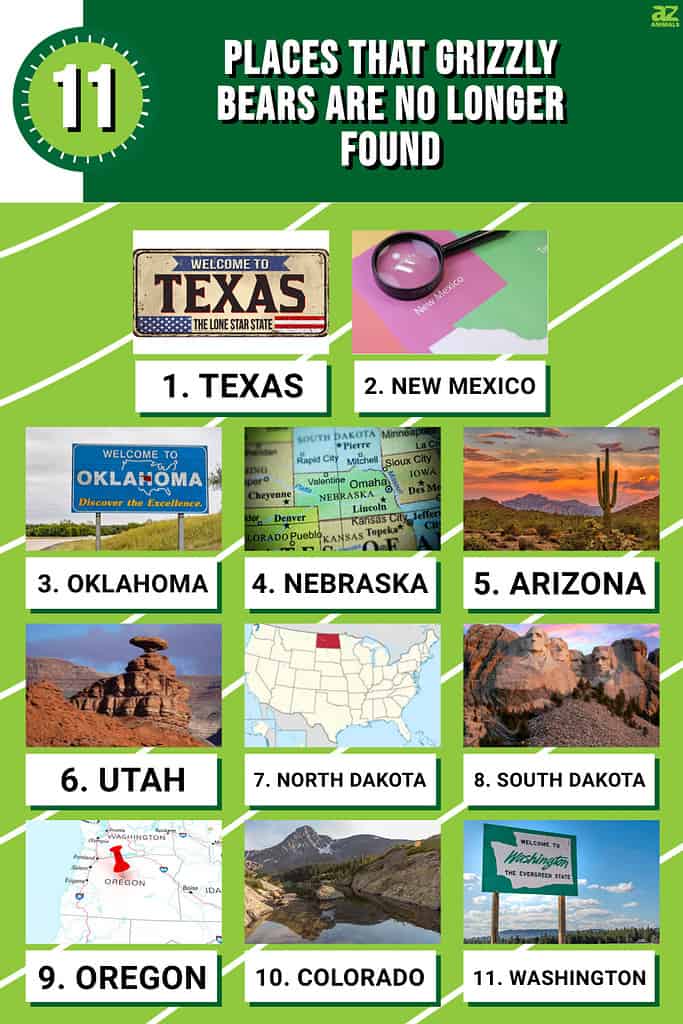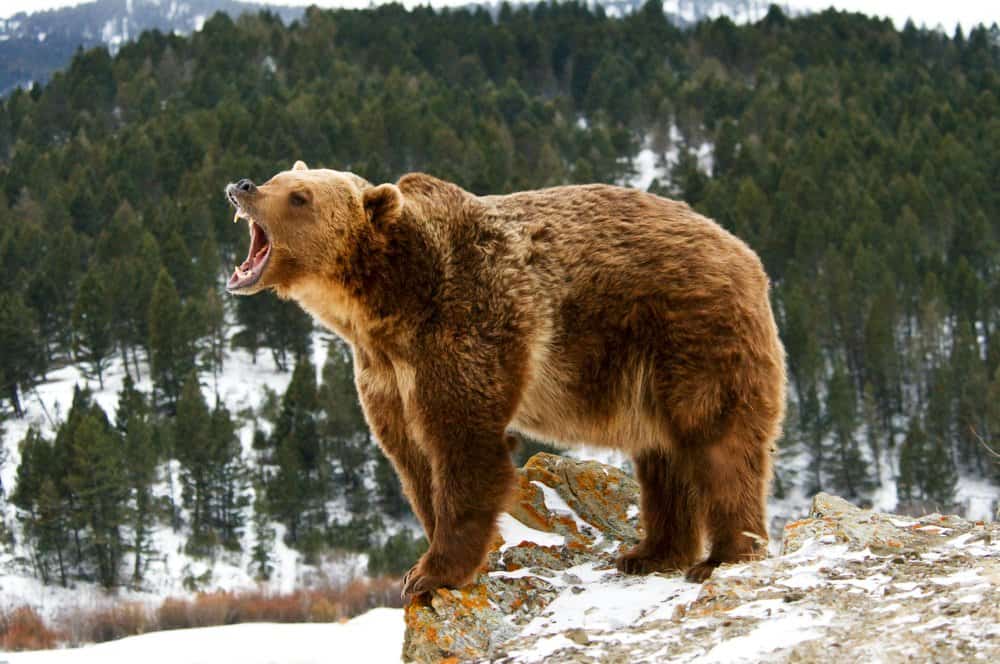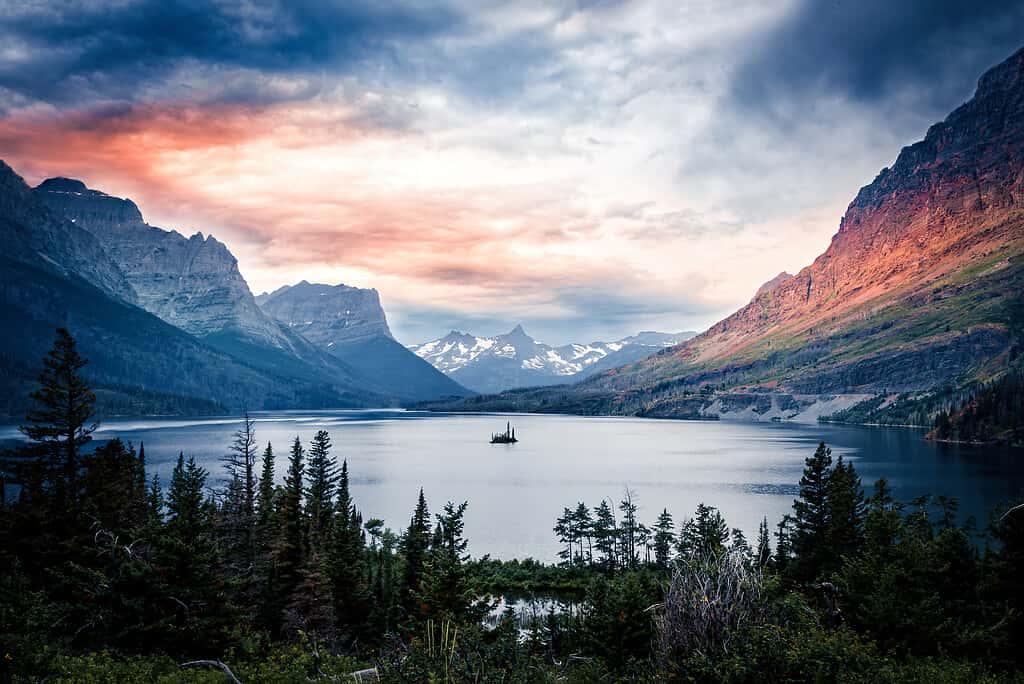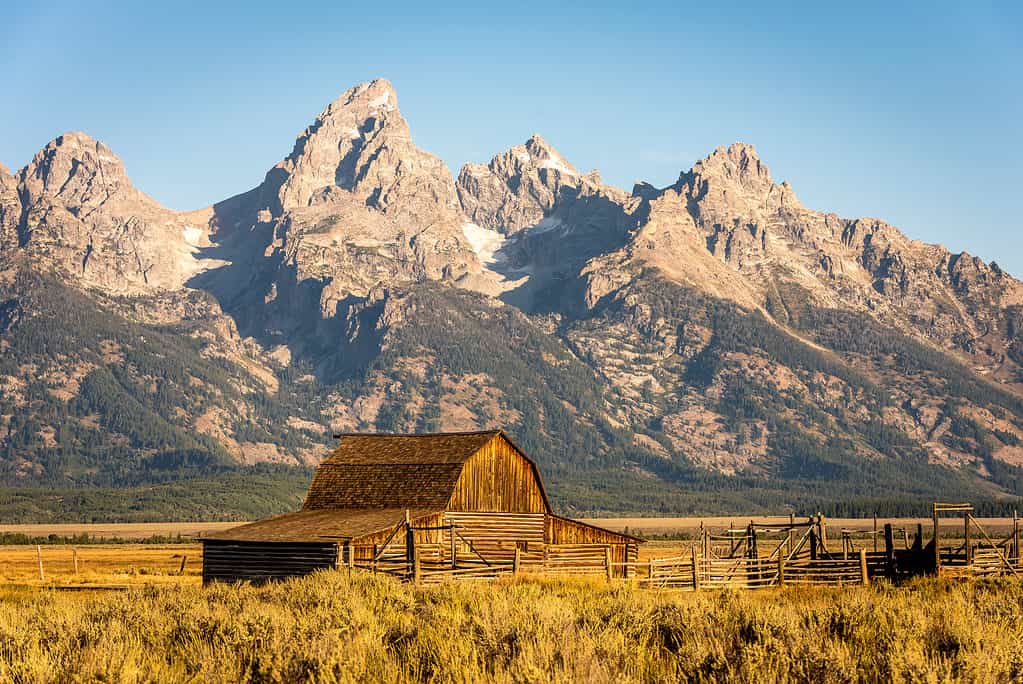Grizzly bears are a ferocious species of bear. They can reach up to 800 pounds and are 8 feet tall when standing. However, despite how physically strong this predator is, their numbers have been steadily decreasing over the years. In the U.S., the grizzly bear is protected as a threatened species under the Endangered Species Act. As a result of their dwindling numbers, fewer than 1,500 grizzlies are left in the lower 48 states and about 31,000 in Alaska.
So are grizzly bears extinct? Here is the answer to the question of what is happening with this ferocious bear and where you cannot find them anymore.
Background On The Grizzly Bear

An easy way to identify grizzly bears is by the prominent hump on their backs. The hump, however, is actually a large muscle powering the bear’s front legs.
©Perpis/Shutterstock.com
Northern American grizzly bears are a subspecies of the brown bear (Ursus arctos). Their main differences are in their diets and geographical locations. The brown bear is mainly found on the coast with access to marine foods, whereas grizzlies live inland.
Grizzly bears are most remembered for their distinctly huge size. After all, grizzly bears are pretty big! Their weight can reach 800 pounds, as mentioned previously. In addition to their enormous size, grizzly bears are also known for their aggressive behavior. They are classified as apex predators in their environment. In addition to hunting caribou, they will hunt a variety of large prey. However, they are also incredibly opportunistic. It is not uncommon for grizzly bears to eat dead animals, salmon, berries, and even clams.
Now that we understand grizzly bears better, let’s explore what happened to them in their natural habitat. After all, why does it now seem as if grizzly bears are extinct?
The Grizzly Bear’s Original Terrain

©Robert Frashure/Shutterstock.com
The grizzly bear’s original range included Alaska, the western half of Canada, more than half of the western United States, and most of Mexico. It is estimated that grizzly bears numbered more than 50,000 in the Lower 48 states at their peak. However, these days, the bears have lost 98% of their historic range, according to the National Wildlife Federation. How could this be?
As the Anglo-Americans invaded their territory, the grizzly bear began to be seen as a major threat. It had no major competition for food until the Anglo-Americans invaded. The Native Americans, however, considered it a sacred animal, though they occasionally hunted the bear as a test of strength.
As a result of their large size and aggressive nature, grizzlies were often encountered by early European explorers. As a result, they decided to hunt them in order to decrease their numbers. During the last century, logging, mining, oil and gas drilling, and land development destroyed the powerful bears’ habitats.
Grizzly bears began to disappear as a result of such hunting and habitat destruction during the settlement of the West. It is estimated that 10,000 grizzlies once lived in California. Grizzly bears were no longer found in the area by 1924.
So where will you no longer find grizzly bears today? Here are some areas where you won’t run into grizzlies anymore.
Status of Grizzly Bears in North America

Grizzly bear populations have increased since they gained protection under the Endangered Species Act.
©NaturesMomentsuk/Shutterstock.com
In the past, grizzly bears were found all over the western United States, Mexico, Canada, and Alaska. Today, grizzly bears aren’t as common in their original habitat as they once were. In fact, the grizzly bear was officially declared an endangered species in the United States back in 1975. In Alberta, grizzlies are also considered threatened, while in British Columbia, they are considered “blue listed” (vulnerable).
11 Places Where You’ll No Longer Find Grizzly Bears

There are several states where grizzly bears can no longer be found. These states include Texas, New Mexico, Oklahoma, Nebraska, Arizona, Utah, the Dakotas, Oregon, and even some parts of Colorado and Washington. By the 1970s, bear populations outside Alaska were restricted to national parks and isolated wilderness areas in Montana, Wyoming, and Idaho.
It did, however, help to increase the population numbers after it was designated a threatened species. Since grizzly populations were protected from hunting and trapping, they have slowly begun to recover.
Areas Where You Can Still Find Grizzly Bears

In addition to weighing upwards of 800 pounds, grizzly bears can measure five to eight feet in length.
©Scott E Read/Shutterstock.com
While Grizzly Bears still roam much of their original habitat in Alaska, they are all but extinct in the lower 48 states. National parks in the U.S. are primarily where grizzly bears are found today. If you’re interested in spotting a grizzly bear then here are the best areas to find them:
Yellowstone National Park, Wyoming

©alpenart/Shutterstock.com
There are few places better in the United States to go wildlife watching than Yellowstone National Park. At the time of passage of the endangered species status, there were 136 grizzly bears in the ecosystem. Around 150 grizzly bears live in Yellowstone National Park. As of 2019, there were 728 bears in the Greater Yellowstone Ecosystem. If you want to increase your chances of spotting a grizzly, then check out the Lamar Valley, Dunraven Pass, Hayden Valley, Swan Lake Flats, and the Northern slope of Mount Washburn.
Glacier National Park, Montana

Saint Mary Lake in the Glacier National Park, Montana
©Martina Birnbaum/iStock via Getty Images
There are many bears in Glacier National Park. It is therefore a great place to spot grizzly bears. Be cautious, however, as bear attacks are common in Glacier. There are about 300 grizzly bears in Glacier National Park. Bears in this population belong to the Northern Continental Divide Ecosystem, which is estimated to have about 1,000 bears. If you’re looking for the best places to see them, check out Logan Pass Area, Two Medicine Area, or around St. Mary Lake.
Grand Teton National Park, Wyoming

Historic barn in front of the Grand Tetons in Moose, Wyoming
©Matt Grimaldi/Shutterstock.com
Grizzly bears have become a popular attraction in Grand Teton National Park in recent years. In addition to large valleys, there are open fields, marshes, and woodlands in Grand Teton. There is a good chance that you will be able to see a grizzly bear in this park since the region is prime bear-viewing territory. Take a look at Willow Flats, Oxbow Bend, Jenny Lake, Cascade, and Death Canyon for the best areas for viewing. Keep in mind, however, that grizzly bears are dangerous and you should always keep your distance.
Summary of 11 Places Grizzly Bears Are No Longer Found
| Number | No More Grizzly Bears in These Areas |
|---|---|
| 1 | Texas |
| 2 | New Mexico |
| 3 | Oklahoma |
| 4 | Nebraska |
| 5 | Arizona |
| 6 | Utah |
| 7 | North Dakota |
| 8 | South Dakotas |
| 9 | Oregon |
| 10 | parts of Colorado |
| 11 | parts of Washington |
The photo featured at the top of this post is © Scott E Read/Shutterstock.com
Thank you for reading! Have some feedback for us? Contact the AZ Animals editorial team.






